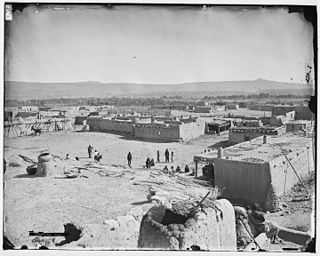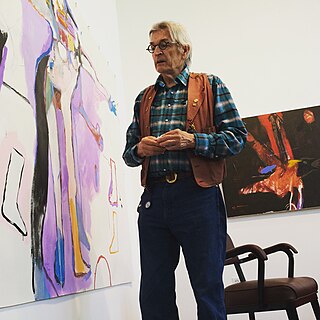Related Research Articles

Cochiti is a census-designated place (CDP) in Sandoval County, New Mexico, United States. A historic pueblo of the Cochiti people, it is part of the Albuquerque Metropolitan Statistical Area. The population was 528 at the 2010 census. Located 22 miles (35 km) southwest of Santa Fe, the community is listed as a historic district on the National Register of Historic Places.

Kewa Pueblo is a federally-recognized tribe of Native American Pueblo people in northern New Mexico, in Sandoval County southwest of Santa Fe. The pueblo is recorded as the Santo Domingo Pueblo census-designated place by the U.S. Census Bureau, with a population of 2,456 at the 2010 census.
Kevin Red Star is a Native American painter from Montana. He is a member of the Crow Tribe of Montana.
Leonidas Tapia (?-1977) was a Puebloan potter from Ohkay Owingeh, New Mexico, United States. She was the wife of Jose Blas Tapia and mother of Mary Trujillo and Tom Tapia. Leonidas made traditional San Juan polychrome redware bowls, jars and wedding vases. She also made micaceous pottery. Some of the designs she used on her pottery include the water serpent, kiva steps and clouds. Leonidas participated in the Santa Fe Indian Market from 1970-1976.
Diego Romero is a Cochiti Pueblo artist living in New Mexico.
Helen Hardin was a Native American painter. She started making and selling paintings, participated in University of Arizona's Southwest Indian Art Project and was featured in Seventeen magazine, all before she was 18 years of age. Creating art was a means of spiritual expression that developed from her Roman Catholic upbringing and Native American heritage. She created contemporary works of art with geometric patterns based upon Native American symbols and motifs, like corn, katsinas, and chiefs. In 1976 she was featured in the PBS American Indian artists series.

Michael Kabotie, also known as Lomawywesa was a Hopi silversmith, painter, sculptor, and poet. He is known for his petroglyph and geometric imagery.

Fred Kabotie was a celebrated Hopi painter, silversmith, illustrator, potter, author, curator and educator. His native name in the Hopi language is Naqavoy'ma which translates to Day After Day.

Richard Elmer "Rick" Bartow was a Native American artist and a member of the Mad River band of the Wiyot Tribe, who are indigenous to Humboldt County, California. He primarily created pastel, graphite, and mixed media drawings, wood sculpture, acrylic paintings, drypoint etchings, monotypes, and a small number of ceramic works.
Stephen Mopope (1898–1974) was a Kiowa painter, dancer, and Native American flute player from Oklahoma. He was the most prolific member of the group of artists known as the Kiowa Six.
Albert Looking Elk, also known as Albert Martinez was a Taos Pueblo painter. Looking Elk is one of the three Taos Pueblo Painters.
Lisa Holt and Harlan Reano are a husband-and-wife team of Pueblo potters and artists from northern New Mexico. They have been making pottery together in 1999, they use traditional Cochiti pottery techniques and create modern work.
Virgil Ortiz is a Pueblo artist, known for his pottery and fashion design from Cochiti Pueblo, New Mexico. Ortiz makes a variety of pottery, including traditional Cochiti figurative pottery, experimental figurative pottery, traditional pottery vessels. His clothing and jewelry designs are influenced by traditional Native American pattern and aesthetics. He is best known for his edgy pottery figures, his contemporary take on the traditional Cochiti pottery figures (monos) from the late 1800s.
Judith Lowry is a Native American artist. Based in Northern California, she is Maidu and Achomawi and enrolled in the Pit River Tribe. Lowry primarily works in acrylics on canvas.

Tonita Peña born as Quah Ah but also used the name Tonita Vigil Peña and María Antonia Tonita Peña. Peña was a renowned Pueblo artist, specializing in pen and ink on paper embellished with watercolor. She was a well-known and influential Native American artist and art teacher of the early 1920s and 1930s.
Joe Hilario Herrera, also known as See Ru, was a Pueblo painter from a mixed Cochiti and San Ildefonso background. He was the son of the artist Tonita Peña and trained at the Santa Fe Indian School.
Juanita Inez Ortiz, also known as Inez Ortiz was a Native American Cochiti Pueblo artist, specializing in pottery. She is of the Herrera family of Pueblo potters in New Mexico, whose work is often found in art collections and in art museums. She was from the Cochiti Pueblo in Cochiti, New Mexico.
Laurencita R. Herrera (1912–1984) was a renowned Native American Cochiti Pueblo artist, specializing in traditional Cochiti figurative pottery called storytellers and her pottery vessels. She is of the Herrera family, a renowned family of Pueblo potters in New Mexico, whose work is often found in art collections and in art museums. She was an actively making pottery between the 1930s through the 1970s and is known as one of the, "finest Cochiti potters of that era".
Josefa Roybal sometimes known as Josephine or Josepha, was a 20th-century Native American artist, a San Ildefonso Pueblo painter and potter. According to one source, she "most likely was born between 1900 and 1905 and most likely died before 1960."
References
- 1 2 3 4 5 "Mateo Romero: 2008 Indian Market Poster Artist." Towa Artists Archived 2008-09-08 at the Wayback Machine (retrieved 17 Jan 09)
- ↑ Clark, Garth. Free Spirit: The New Native American Potter. Hertogenbosch, Netherlands: Stedelijik Museum's, 2006: 102-123.
- 1 2 3 4 Schaaf, Gregory. "Four Painters." Native Peoples Magazine. 2 Jan 2005 (retrieved 17 Jan 09)
- ↑ "Stretching the Canvas: Eight Decades of Native Painting". National Museum of the American Indian. Retrieved 7 March 2021.